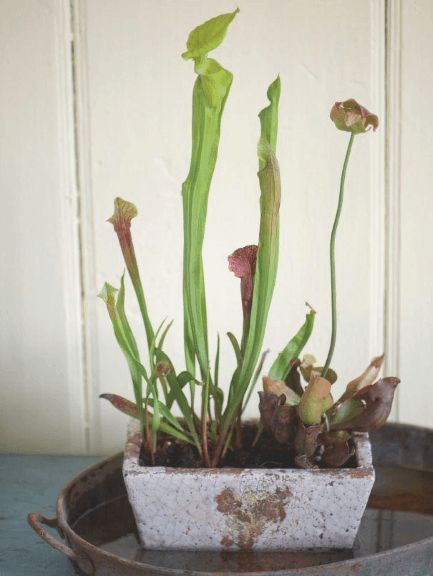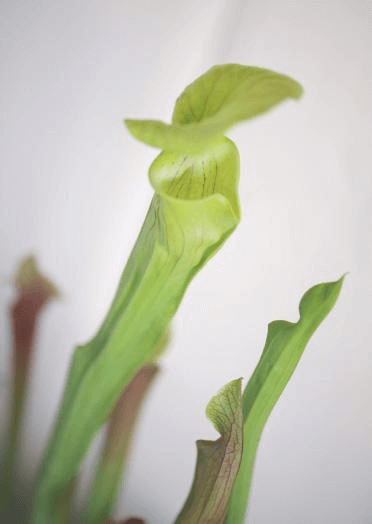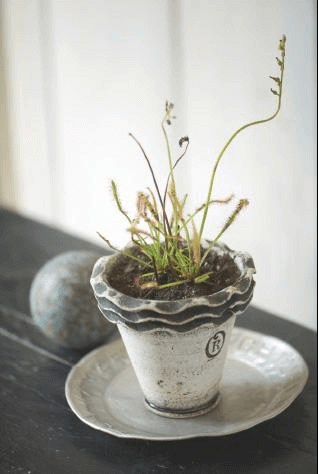[Ebook Việt hóa] The Unexpected Houseplant: 220 Extraordinary Choices for Every Spot in Your Home
[Ebook Việt Hoá] The Unexpected Houseplant: Carnivorous Plants (các loại cây ăn thịt)
- Nguồn: [Ebook] The Unexpected Houseplant: 220 Extraordinary Choices for Every Spot in Your Home –
- Biên tập: Dũng Cá Xinh (Tháng 02/2022)
- Dịch: Team Codai.net
English
CARNIVOROUS PLANTS
THERE IS A fairly broad chasm between me and anything having to do with greasy grimy gopher guts. I never embraced sci-fi, horror movies, or anything remotely leaning in the gory direction. Indeed, I’m a lifelong vegetarian, and that should tell you a lot. However, some of my best friends are meat-eaters. Take the pitcher plant, for example.

I like to think I’m attracted to sarracenias because they are gorgeous. Solely on the basis of their physical appearance, I made a beeline in the pitcher plant’s general direction. And why keep an oddball of this caliber at arm’s length outdoors? Fortunately, sarracenias turned out to be possible and pleasurable houseplants. We’re talking funnel-shaped, tube-like leaves that poke up from the ground (or lay back, in the case of Sarracenia purpurea). They’re leathery, their veins are accented, and they have a little bonnet at their tip, sometimes shaped like a lid that is ajar. In other words, pitcher plants look vaguely supernatural. Add their eating habits to this outlandish garb and you’ve got the makings of an Alfred Hitchcock movie. The foliage has nectaries that attract insects. While the insects are in exploratory mode, they crawl around the tube, which gets waxier further from the opening. It’s so slippery that hapless bugs (and the misadventures of bugs seemingly make the world go round) tumble into the depths of the leaf. In this case, a second chance isn’t in the poor little pollinator’s cards as it drowns in the accumulated water. The pitcher plant ingests the lip-smacking goodness of its yummy prey, leaving the outer body parts to form a slurry in its depths. Look within a tube on a pitcher plant, and there’s going to be considerable grossness going on. It’s the smoothie from hell. Be prepared for yuck even indoors—sarracenias manage to wine and dine on any stray fruit flies that happen to be carousing. If that image bothers you, feel free to empty out the pitcher periodically. Or you can turn the other cheek and let nature take its course.

When one of my nursery friends divulged the knowledge that sarracenias need a sub-freezing sequence, it was news to me. I’d always grown them successfully indoors throughout the winter. Granted, they’re not in their finest form at that juncture (although they never went completely dormant), but they survived to rally and blossom in spring. The blossoms are deep burgundy and shiny, and look like a combination spaceship-parachute-umbrella. They shoot up twice as tall as the leaves and are definitely an event in spring.
The sarracenias aren’t the only carnivorous plants in my inventory. I also do a few sundews (Drosera species). They aren’t equally thrilling from a distance, but I love the sparkling, jewel-like quality of the tentacles that enwrap and strangle their prey. Mine don’t seem to have an appetite equal to the pitcher plants, but they are easy to grow, mildly entertaining, and definitely different, so I invite them to the party.
Occasionally, I try (and fail with) a Venus flytrap (Dionaea muscipula). It lives for a month or two under my stewardship, and then goes dormant (also known as dead). I’ve tried them in the open and in terrariums. Nothing seems to work. Dormancy is the kiss of death in my house. Although they are undeniably thrilling for a while, it isn’t a lasting relationship.
Just for the record, I have never grown a nepenthes in my home. Their preference for warm temperatures, high humidity, and warm water is just too daunting. It’s fine to host a modest carnivorous plant that demands high humidity in a terrarium, but nepenthes are huge plants with dangling lidded pitchers that catch bugs. In other words, they are not easily clapped into a humid chamber. They are undeniably fascinating, but I leave them to reside in toasty greenhouses and visit them there.

All carnivorous plants enjoy similar growing conditions. They love bright light and soggy roots. My entire collection sits in a watertight metal tray with sides that can be filled and refilled with water as the level dwindles. The even moisture factor is key, and I find that it’s more important than light. Because I don’t really have any super bright venues in my home, most of the carnivorous crowd is relegated to part shade. The whole menagerie takes lower sunbeams in their stride (except the Venus flytrap).
The potting medium can be dicey. I’ve seen a combination of peat moss and sand used (50-50 is usually recommended). Sphagnum moss has been associated with carnivorous plants as a potting medium, but it has also been linked with a very serious skin condition, so I avoid it entirely and urge you to do likewise. I have never needed to repot my collection—they seem to grow fine in their original pots indefinitely. Keep in mind that carnivorous plants are custom-made to survive in protein- and nutrient-poor ecosystems. They are indigenous to bogs and supplement their diet with their kinky meals. They detest fertilizer. Carnivorous plants don’t actually need to eat insects to survive; the bugs are supplemental. Of course, there’s no way to dissuade kids from trying to cram flies into their carnivorous pets. But an arm of a Venus flytrap with prey inside will remain shut, and then turn black and rot. Pitcher plants, on the other hand, can gorge on thousands of insects and still be their handsome, smiling selves.
Sarracenia species, Drosera species, Dionaea muscipula
- PITCHER PLANTS, SUNDEWS, AND VENUS FLYTRAP
| FLOWERS | Sarracenias have burgundy parachutes on tall stems; Venus flytraps have small white flowers jutting above the foliage |
| FOLIAGE | Ornamental in all cases |
| OTHER ATTRIBUTES |
Pitcher plants make great cut flowers |
| EXPOSURE | South |
| SIZE | Sarracenias are 1–2 feet (30–61cm) in height; Droseras and Venus flytraps are ground hugging |
| WATER REQUIREMENTS |
Heavy drinkers; use purified water |
| OPTIMUM NIGHTTIME TEMPERATURE |
50–55°F (10–12°C) |
| RATE OF GROWTH | Slow |
| SOIL TYPE | Mossy, boggy |
| FERTILIZING | None |
| PROBLEMS | They can go dormant and fail to return. But they aren’t pestered by insect attacks—instead, they are their own eliminators. |
Tiếng Việt
Các loại cây ăn thịt
Có một hố sâu ngăn cách khá rộng giữa tôi và bất cứ thứ gì liên quan đến ruột gan ngỗng bẩn thỉu. Tôi chưa bao giờ chấp nhận những bộ phim khoa học viễn tưởng, kinh dị hay bất cứ thứ gì từ xa nghiêng về hướng đẫm máu. Thật vậy, tôi là một người ăn chay cả đời và điều đó sẽ cho bạn biết rất nhiều điều. Tuy nhiên, một số người bạn thân nhất của tôi là những người ăn thịt. Lấy ví dụ như cây Nắp Ấm.

Tôi thích nghĩ rằng mình bị thu hút bởi cây sarracenias vì chúng rất đẹp. Chỉ dựa trên cơ sở ngoại hình của chúng, tôi đã xác định được hướng đi chung của cây Nắp Ấm. Và tại sao lại để một quả cầu kỳ quặc tầm cỡ này ở ngoài trời? May mắn thay, sarracenias hóa ra có thể được trồng trọt trong nhà. Chúng ta đang nói đến những chiếc lá hình phễu, hình ống, nhô lên khỏi mặt đất (hoặc nằm ngửa, trong trường hợp của Sarracenia purpurea). Chúng có chất liệu da, các đường gân của chúng có điểm nhấn và có một chút nắp ca-pô ở đầu, đôi khi có hình dạng giống như một cái nắp mở ra. Nói cách khác, cây Nắp Ấm trông có vẻ siêu phàm. Thêm thói quen ăn uống của họ vào bộ trang phục kỳ lạ này và bạn đã có được bộ phim của Alfred Hitchcock. Các tán lá có mật thu hút côn trùng. Trong khi côn trùng ở chế độ thám hiểm, chúng sẽ bò xung quanh ống, ống này càng sáp hơn từ lỗ mở. Nó trơn đến nỗi những con bọ không may (và những trò sai lầm của những con bọ dường như khiến thế giới quay tròn) chui vào sâu trong chiếc lá. Trong trường hợp này, cơ hội thứ hai không nằm trong thẻ của loài thụ phấn nhỏ bé tội nghiệp khi nó chết chìm trong nước tích tụ. Cây Nắp Ấm ăn thịt con mồi ngon lành của nó, để lại các bộ phận cơ thể bên ngoài để tạo thành bùn ở sâu bên trong. Nhìn vào trong một cái ống trên cây nắp ấm, và sẽ có một khoản thu nhập đáng kể đang diễn ra. Nếu hình ảnh đó làm phiền bạn, vui lòng vứt hết cây đi. Hoặc bạn có thể xoay phần bên kia và để cây được diễn ra tự nhiên mà không ảnh hưởng đến bạn.


Tất cả các cây ăn thịt đều được hưởng các điều kiện phát triển như nhau. Chúng thích ánh sáng rực rỡ và rễ cây sũng nước. Toàn bộ bộ sưu tập của tôi nằm trong một khay kim loại kín nước với các mặt có thể được đổ và đổ đầy nước khi mực nước cạn dần. Yếu tố độ ẩm đồng đều là yếu tố then chốt và tôi thấy rằng yếu tố này quan trọng hơn ánh sáng. Bởi vì tôi thực sự không có bất kỳ địa điểm siêu sáng nào trong nhà của mình, nên hầu hết đám đông ăn thịt đều bị loại khỏi bóng râm một phần. Toàn bộ đón những tia nắng thấp hơn trong sải chân của họ (ngoại trừ chiếc kim thăng bằng sao Kim).
Ruột bầu có thể được cắt hạt lựu. Tôi đã thấy sự kết hợp giữa rêu than bùn và cát được sử dụng (50-50 thường được khuyến nghị). Rêu Sphagnum có liên quan đến thực vật ăn thịt làm giá thể, nhưng nó cũng có liên quan đến tình trạng da rất nghiêm trọng, vì vậy tôi tránh hoàn toàn và mong bạn làm như vậy. Tôi chưa bao giờ cần thay chậu cho bộ sưu tập của mình — chúng dường như phát triển tốt trong chậu ban đầu của chúng vô thời hạn. Hãy nhớ rằng thực vật ăn thịt được tạo ra tùy chỉnh để tồn tại trong các hệ sinh thái nghèo protein và dinh dưỡng. Chúng là bản địa của các bãi lầy và bổ sung vào chế độ ăn uống của chúng với các bữa ăn kinky. Họ ghét phân bón. Thực vật ăn thịt không thực sự cần ăn côn trùng để tồn tại; các lỗi là bổ sung. Tất nhiên, không có cách nào để ngăn cản những cây non nhồi nhét ruồi vào vật nuôi ăn thịt của chúng. Nhưng một cánh tay của con ruồi Venus với con mồi bên trong sẽ vẫn đóng lại, sau đó chuyển sang màu đen và thối rữa. Mặt khác, cây Nắp Ấm có thể ngấu nghiến hàng nghìn con côn trùng mà vẫn giữ được vẻ đẹp, tươi cười của chúng.
Loài Sarracenia, loài Drosera, Dionaea muscipula
- CÂY NẮP ẤM, CÂY GỌNG VÓ, VÀ CÂY BẪY KẸP
| HOA | Cây Nắp Ấm có những chiếc dù màu đỏ tía trên thân cây cao; cây Bẫy Kẹp có những bông hoa nhỏ màu trắng nhô lên trên những tán lá |
| TÁN LÁ | Trang trí trong mọi trường hợp |
| THUỘC TÍNH KHÁC | Cây Nắp Ấm tạo ra những bông hoa cắt cành tuyệt vời |
| HƯỚNG | Phía Nam |
| KÍCH THƯỚC | Cây Nắp ẤM cao 1–2 feet (30–61cm); cây Gọng Vó và cây Bẫy Kẹp đang ôm sát mặt đất |
| YÊU CẦU VỀ NƯỚC | Cần nhiều nước; sử dụng nước tinh khiết |
| NHIỆT ĐỘ ĐÊM TỐI ƯU | 50–55°F (10–12°C) |
| TỐC ĐỘ TĂNG TRƯỞNG | Chậm |
| LOẠI ĐẤT | Rêu, sa lầy |
| PHÂN BÓN | Không |
| CÁC VẤN ĐỀ | Chúng có thể không hoạt động và không thể quay trở lại. Nhưng chúng không bị quấy rầy bởi các cuộc tấn công của côn trùng – thay vào đó, chúng là những người diệt trừ riêng. |
![[Ebook Việt Hoá] The Unexpected Houseplant: Carnivorous Plants (các loại cây ăn thịt) [Ebook Việt Hoá] The Unexpected Houseplant: Carnivorous Plants (các loại cây ăn thịt)](https://vn1.vdrive.vn/codai.net/2021/02/ebook-viet-hoa-220-lua-chon-cay-canh-trong-nha-31-carnivorous-plants.jpg)


